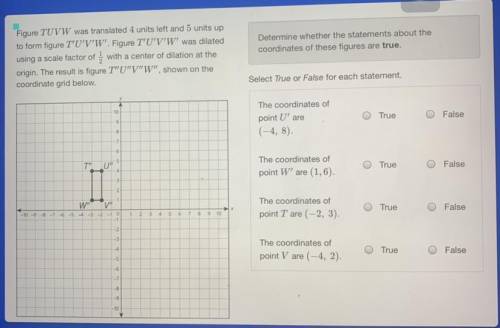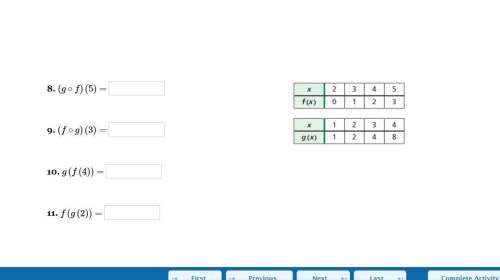
Mathematics, 21.11.2020 01:00 happyabbie23
Figure TUVW was translated 4 units left and 5 units up
to form figure T'U'V'W'. Figure T'U'V'W' was dilated
using a scale factor of } with a center of dilation at the
origin. The result is figure T'U"V"W", shown on the
coordinate grid below. PLEASE HELP ME


Answers: 1


Another question on Mathematics

Mathematics, 21.06.2019 17:00
Me on this one i will give you 20pts. answer should be in detail . this is the discussion topic. one of the most fiercely debated topics in sports is the hot hand theory. the hot hand theory says that success breeds success. in other words, rather than each shot a basketball player takes or each at-bat a baseball player has being an independent event, the outcome of one event affects the next event. that is, a player can get hot and make a lot of shots in a row or get a lot of hits in a row. the hot hand theory, however, has been shown to be false in numerous academic studies. read this article, which discusses the hot hand theory as it relates to a professional basketball player. state whether you agree or disagree with the hot hand theory, and give reasons for your opinion. be sure to use some of the terms you’ve learned in this unit, such as independent event, dependent event, and conditional probability, in your answer.
Answers: 2

Mathematics, 21.06.2019 17:00
The following graph shows the consumer price index (cpi) for a fictional country from 1970 to 1980? a.) 1976 - 1978b.) 1972 - 1974c.) 1974 - 1976d.) 1978 - 1980
Answers: 1


Mathematics, 21.06.2019 23:00
Each of the following data sets has a mean of x = 10. (i) 8 9 10 11 12 (ii) 7 9 10 11 13 (iii) 7 8 10 12 13 (a) without doing any computations, order the data sets according to increasing value of standard deviations. (i), (iii), (ii) (ii), (i), (iii) (iii), (i), (ii) (iii), (ii), (i) (i), (ii), (iii) (ii), (iii), (i) (b) why do you expect the difference in standard deviations between data sets (i) and (ii) to be greater than the difference in standard deviations between data sets (ii) and (iii)? hint: consider how much the data in the respective sets differ from the mean. the data change between data sets (i) and (ii) increased the squared difference îł(x - x)2 by more than data sets (ii) and (iii). the data change between data sets (ii) and (iii) increased the squared difference îł(x - x)2 by more than data sets (i) and (ii). the data change between data sets (i) and (ii) decreased the squared difference îł(x - x)2 by more than data sets (ii) and (iii). none of the above
Answers: 2
You know the right answer?
Figure TUVW was translated 4 units left and 5 units up
to form figure T'U'V'W'. Figure T'U'V'W' was...
Questions

English, 03.08.2019 17:30





Mathematics, 03.08.2019 17:30


Mathematics, 03.08.2019 17:30



Geography, 03.08.2019 17:30

History, 03.08.2019 17:30












